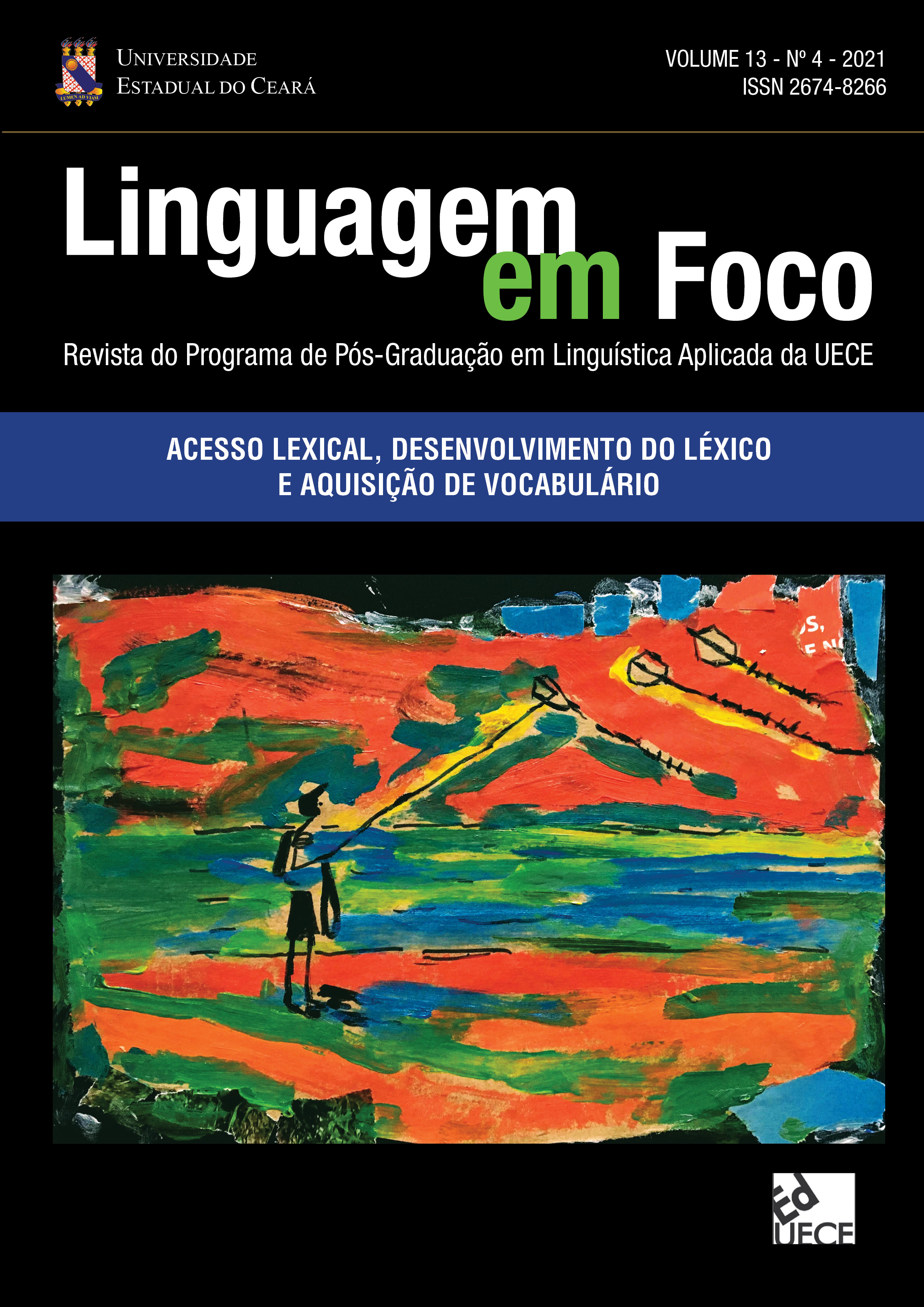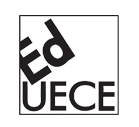Acesso lexical em língua minoritária
A seleção de palavras escritas em hunsriqueano e pomerano
DOI:
https://doi.org/10.46230/2674-8266-13-7371Palavras-chave:
Acesso lexical, Metodologia, Leitura, Hunsriqueano, PomeranoResumo
Estudos sobre acesso lexical têm priorizado línguas majoritárias em detrimento das línguas minoritárias. Porém, as comunidades de falantes de língua minoritária, como o hunsriqueano e o pomerano, demonstram um interesse cada vez maior em ler e escrever em uma de suas línguas maternas. Diante disso, o objetivo deste trabalho é discutir questões metodológicas envolvidas na seleção de palavras escritas em hunsriqueano e pomerano para uma tarefa de decisão lexical. Com esse experimento, investigamos o acesso a palavras escritas em língua minoritária. Este estudo discute as especificidades da seleção de estímulos psicolinguísticos em duas línguas minoritárias, considerando principalmente a falta de materiais escritos e de padronização, as diferenças entre ambas as línguas e as semelhanças com a língua alemã. A contribuição deste estudo evidencia a importância de pesquisas que envolvam línguas minoritárias, a fim de cooperar nas necessidades dos falantes, favorecendo, assim, a manutenção das línguas minoritárias.
Downloads
Referências
ABUTALEBI, J. et al. Late acquisition of literacy in a native language. Human Brain Mapping, v. 28, n. 1, p. 19-33, 2007. https://doi.org/10.1002/hbm.20240
ALTENHOFEN, C. V. Hunsrückisch in Rio Grande do Sul: Ein Beitrag zur Beschreibung einer deutschbrasilianischen Dialektvarietät im Kontakt mit dem Portugiesischen. Stuttgart: Steiner, 1996.
ALTENHOFEN, C. V. et al. Fundamentos para a escrita do Hunsrückisch falado no Brasil. Revista Contingentia, v. 2, n. 51, p. 73-87, 2007.
ALTENHOFEN, C. V. Dachsprachenwechsel und Varietätenabgrenzung im Kontakt zwischen Hunsrückisch und Portugiesisch in Brasilien. In: B. Fred (ed.). Festschrift für Harald Thun zum 60. Geburtstag. Kiel: Westensee-Verlag, p. 1-26, 2010.
ALTENHOFEN, C. V. Bases para uma política linguística das línguas minoritárias no Brasil. In: NICOLAIDES, C. et al. (orgs.). Política e Políticas Linguísticas. Campinas: Pontes Editores, 2013, p. 93-116.
AMMON, U. Die Stellung der deutschen Sprache in der Welt. Berlin: De Gruyter, 2015. https://doi.org/10.1515/9783110241075
BARCELOS, L. O acesso lexical em trilíngues brasileiros falantes de português, inglês e francês, 2016. 158 f. Dissertação (Mestrado em Linguística Aplicada) - Programa de Pós-Graduação de Letras da Universidade Federal do Rio Grande do Sul. Porto Alegre, 2016.
BEILKE, N. S. V. Pommersche Korpora: uma proposta metodológica para compilação de corpora dialetais. 2016. 285 f. Dissertação (Mestrado em Estudos Linguísticos). Universidade Federal de Uberlândia, Uberlândia, 2016.
BLANK, C. A. A influência grafo-fônico-fonológica na produção oral e no processamento de priming em multilíngues: uma perspectiva dinâmica. 2013. 225 f. Tese (Doutorado em Letras) – Programa de Pós-graduação em Letras, Universidade Católica de Pelotas (UCPel), Pelotas, 2013.
BOSMA, E.; NOTA, N. Cognate facilitation in Frisian–Dutch bilingual children’s sentence reading: An eye-tracking study. Journal of Experimental Child Psychology, v. 189, p. 1-18, 2020. https://doi.org/10.1016/j.jecp.2019.104699
BRYSBAERT, M. et al. The Word Frequency Effect. Experimental Psychology, v. 58, n. 5, p. 412–424, 2011. https://doi.org/10.1027/1618-3169/a000123
DIJKSTRA, T.; VAN HEUVEN, W. J. B. The architecture of the bilingual word recognition system: From identification to decision. Bilingualism: Language and Cognition, v. 5, n. 3, p. 175–197, 2002. https://doi.org/10.1017/S1366728902003012
DIJKSTRA, T. Bilingual visual word recognition and lexical access. In: KROLL, J.; DE GROOT, A. M. B. (Eds.). Handbook of Bilingualism: Psycholinguistic Approaches. Oxford: Oxford University Press, p. 179–201, 2005.
FIELD, J. Psycholinguistics: A resource book for students. Psychology Press, 2003.
FONTES, A. B.; BRENTANO, L.; TOASSI, P. F.; SITTIG, C.; FINGER, I. Evidence of non-selective lexical access in children from a Portuguese-English bilingual school. PROLÍNGUA, v. 15, n. 2, p. 183–197, 2020. https://doi.org/10.22478/ufpb.1983-9979.2020v15n2.54901
FOERSTE, E.; FOERSTE, G. M. S. Língua, Cultura e Educação do Povo Tradicional Pomerano. Educação em Revista, n. 33, p.1-24, 2017. https://doi.org/10.1590/0102-4698153099
IPOL. Lista de línguas cooficiais em municípios brasileiros, 2021. Instituto de Investigação e Desenvolvimento em Política Linguística. Disponível em: http://ipol.org.br/lista-de-linguas-cooficiais-em-municipios-brasileiro/. Acesso em: 23 nov. 2021.
GUASCH, M. et al. NIM: A Web-based Swiss Army knife to select stimuli for psycholinguistic studies. Behavior Research Methods, v. 45, p. 765-771, 2013. https://doi.org/10.3758/s13428-012-0296-8
KEULEERS, E.; BRYSBAERT, M. Wuggy: A multilingual pseudoword generator. Behavior Research Methods, v. 42, n. 3, p. 627–633, 2010. https://doi.org/10.3758/BRM.42.3.627
KERKHOFS, R. et al. Testing a model for bilingual semantic priming with interlingual homographs: RT and N400 effects. Brain Research, v. 1068, n. 1, p. 170–183, 2006. https://doi.org/10.1016/j.brainres.2005.10.087
KRAMER, R.; MOTA, M. B. Effects of bilingualism on inhibitory control and working memory: a study with early and late bilinguals. Gragoatá, v. 38, p. 309–331, 2015. https://doi.org/10.22409/gragoata.v20i38.33312
LIMBERGER, B. K. Processamento da leitura e suas bases neurais: um estudo sobre o hunsriqueano. 2018. 269 f. Tese – Programa de Pós-graduação em Letras, Pontifícia Universidade Católica do Rio Grande do Sul, Porto Alegre, 2018. https://doi.org/10.13140/RG.2.2.28790.42563
LIMBERGER, B. K. et al. A língua pomerana do rio grande do sul: revisão de literatura. Web Revista SOCIODIALETO, [S.l.], v. 12, n. 34, p. 1-36, 2021. https://doi.org/10.48211/sociodialeto.v12i34.390
MACHADO, L. L. Standard e substandard em contato com o português: variação na competência de fala em Hochdeutsch de falantes de Hunsrückisch. 169 f. Dissertação (Mestrado em Letras) – Programa de Pós-graduação em Letras, Universidade Federal do Rio Grande do Sul, Porto Alegre, 2016.
MARIAN, V. et al. CLEARPOND: Cross-Linguistic Easy-Access Resource for Phonological and Orthographic Neighborhood Densities. PLoS ONE, v. 7, n. 8, p. 1–11, 2012. https://doi.org/10.1371/journal.pone.0043230
PINTO, N. B.; FONTES, A. B. A. L. Controle metodológico: criação de um corpus para estudos sobre o processamento lexical de indivíduos bilíngues e multilíngues. Gragoatá, v. 23, n. 46, p. 374-404, 30 ago. 2018. https://doi.org/10.22409/gragoata.v23i46.33582
PINTO, N. B.; FONTES, A. B. A. L. O acesso lexical em falantes multilíngues português-inglês-italiano. Veredas-Revista de Estudos Linguísticos, v. 24, n. 1, p. 291-316, 2020. https://doi.org/10.34019/1982-2243.2020.v24.30512
SAMBAQUY-WALLNER, V. A língua alemã em São José do Hortêncio - RS. Caxias do Sul: EDUCS, 1998.
SCHAUMLOEFFEL, M. A. Estudo da Interferência do Português da Variedade Dialetal Hunsrück Falada em Boa Vista do Herval. 2003. 136 f. Dissertação (Mestrado em Letras) – Programa de Pós-graduação em Letras, Universidade Federal do Paraná, Curitiba, 2003.
SCHNEIDER, A. Dicionário escolar conciso: português-pomerano/pomerisch- portugijsisch. Porto Alegre: Evangraf, 2019.
STEFFEN, J.; ALTENHOFEN, C. V. Spracharchipele des Deutschen in Lateinamerika: Dynamik der Sprachvernetzungen im mehrsprachigen Raum. Zeitschrift für Dialektologie und Linguistik, v. 81, n. 1, p. 34–60, 2014.
TOASSI, P. F. P.; MOTA, M. B.; TEIXEIRA, E. N. O efeito de palavras cognatas no acesso lexical do inglês como terceira língua. Cadernos de Tradução, v. 40, n. 2, p. 74–96, set./dez, 2020. https://doi.org/10.5007/2175-7968.2020v40nesp2p74
TRESSMANN, I. Dicionário Enciclopédico Pomerano-Português. Vitória: Gráfica e Encadernadora Sodré, 2006.
TRESSMANN, I. O pomerano: uma língua baixo-saxônica. Educação, cultura e sociedade. Revista da Farese (Faculdade da Região Serrana). Santa Maria de Jetibá, v. 1, p. 10-21, 2008.
VAN ASSCHE, E.; DUCK, W.; HARTSUIKER, R. J. Context Effects in Bilingual Sentence Processing: Task Specificity. In: HEREDIA, R. R. et al. (eds.). Methods in Bilingual Reading Comprehension Research. The Bilingual Mind and Brain Book Series 1, Methods in Bilingual Reading Comprehension Research. New York, NY: Springer New York, p. 11-31, 2016. https://doi.org/10.1007/978-1-4939-2993-1_2
VAN HEUVEN, W. J. B.; DIJKSTRA, T.; GRAINGER, J. Orthographic Neighborhood Effects in Bilingual Word Recognition. Journal of Memory and Language, v. 39, p. 458–483, 1998. https://doi.org/10.1006/jmla.1998.2584
VAHL, M. S. Motivações para a alternância de código português-pomerano entre alunos do Ensino Médio de Arroio do Padre – RS. 2017. 165 f. Dissertação (Mestrado em Letras) - Programa de Pós-Graduação em Letras do Centro de Letras e Comunicação, Universidade Federal de Pelotas. Pelotas, 2017.
VERBAND DEUTSCHER VEREINE. Cem anos de germanidade no Rio Grande do Sul. Tradução de: Arthur Blásio Rambo. São Leopoldo: Editora Unisinos, 1999.
WIESEMANN, U. Contribuição ao desenvolvimento de uma ortografia da língua Hunsrik falada na América do Sul. Associação Internacional de Lingüística–SIL, Cuiabá, p. 1-37, 2008.
Publicado
Como Citar
Edição
Seção
Licença
Copyright (c) 2022 Lisandro Völz, Bernardo Kolling Limberger

Este trabalho está licenciado sob uma licença Creative Commons Attribution 4.0 International License.
Os autores que publicam na Linguagem em Foco concordam com os seguintes termos:
- Os autores mantêm os direitos autorais e concedem à revista o direito de primeira publicação. Os artigos estão simultaneamente licenciados sob a Creative Commons Attribution License que permite a partilha do trabalho com reconhecimento da sua autoria e da publicação inicial nesta revista.
- Os conceitos emitidos em artigos assinados são de absoluta e exclusiva responsabilidade de seus autores. Para tanto, solicitamos uma Declaração de Direito Autoral, que deve ser submetido junto ao manuscrito como Documento Suplementar.
- Os autores têm autorização para disponibilizar a versão do texto publicada na Linguagem em Foco em repositórios institucionais ou outras plataformas de distribuição de trabalhos acadêmicos (ex. ResearchGate, Academia.edu).





























